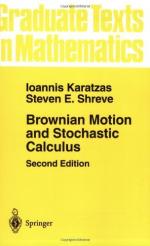|
This section contains 971 words (approx. 4 pages at 300 words per page) |

|
Brownian motion is the incessant random motion exhibited by microscopic particles immersed in a fluid. The effect is named after its discoverer, Robert Brown, a Scottish botanist who first noticed the effect in a suspension of pollen grains in 1827. It was determined quickly by Brown and others that the effect is exhibited by small particles of any material when they are suspended in a liquid or gas, and is not unique to pollen grains or other once-living matter.
We now understand Brownian motion as the result of the many millions of collisions with molecules of the fluid experienced by the particle being observed each second. While the average velocity of the molecules in a stationary fluid is zero, the average velocity of the small number of molecules which will collide with the particle at any instant will fluctuate about zero, producing a net force continuously changing...
|
This section contains 971 words (approx. 4 pages at 300 words per page) |

|


